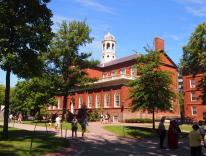Like every other sector of the economy, Catholic higher education is subject to the larger forces of finance, government regulation, and broad cultural, technological, and demographic changes. These changes cannot be ignored or mastered; at best, they can be navigated with whatever skill and vision are available. In Catholic Higher Education and Catholic Social Thought, editors Bernard Prusak and Jennifer Reed-Bouley add another level of complexity to the challenges facing Catholic higher education: the clash of the common-good vision of Catholic social teaching with a regnant culture of neoliberalism, in which all aspects of higher education are viewed through the lens of market share and profit.
Such a culture works better for some than for others. It is not news that your local Catholic college with an enrollment of around 1,500 undergraduates is scrambling. But how many know that Boston College’s endowment assets reached $2.47 billion in 2019—exceeded, among Catholic schools, only by Notre Dame’s $11.32 billion. While Matt Mazewski’s contribution to this collection is careful to document the full range between these two poles, many Catholic colleges and universities (CCUs) are clustered at the low end, leaving them with few defenses in the higher-ed arms race. This impacts the delivery of the social mission of Catholic schools on many fronts: they struggle to pay their faculty and staff a reasonable wage; they struggle to offer scholarship dollars that would stave off overwhelming debt for students in need; and they are vulnerable to pressures to curtail or close humanities departments in favor of STEM and professional majors.
Catholic social thought—first officially formulated by Pope Leo XIII in 1891 in response to the economic conditions caused by the industrial revolution—has consistently championed unions and other labor associations as a humanizing counter to modern capitalism. Most CCUs in the United States, however, have consistently resisted unionization, arguing that unions would subject them to government oversight and thereby infringe on their religious liberty. In his essay, Joseph A. McCartin reports that Georgetown University ($1.8 billion in endowment assets in 2019) has found a way around this problem by implementing a model for “private election agreements that do not involve the government,” thus protecting the Jesuit university’s Catholic character while meeting the socially just call for a “union.” Because of its relative wealth, Georgetown is able to support the higher wages that result from unionization; unwilling or financially unable to follow suit, most other CCUs fall back on “religious liberty.” McCartin lays out other important Catholic dimensions of the labor question. Faculties are now divided into two camps: “citizens” (tenured and tenure-track faculty) and “guest workers” (adjuncts). This painful fact is familiar to faculty members themselves, whose clarion calls for social justice tend to focus on the world “beyond campus gates.”
The roots of Catholic social thought—its theological and anthropological basis—are often lost in campus discussions, which reduce it to a lightly christened version of secular social justice. Acknowledging that Catholic social thought all too often appears on the radar of Catholic higher education only as a “cudgel for faculty to wield against the administration,” the editors make their case for a much deeper appropriation of this tradition. The formation of senior administrators and boards of trustees often lacks a robust theological dimension. New presidents of Catholic colleges now commonly signal their relationship to the Catholic identity of their institution’s founding order simply by “showing the flag” as a fan of the tradition in question. This book could have done with even more strategizing about how to develop a deep leadership bench for the future—an incoming provost or president usually doesn’t have the time for this effort, given the practical demands of those roles. Administrators need guidance.
The contributors to this volume all understand that now is a critical moment for the Catholic character of these institutions, and that the failure to engage their Catholic mission is also a failure to engage some profound systemic issues for higher ed in general. Tia Noelle Pratt and Maureen O’Connell explain the racial dynamics at CCUs not merely as “a reflection of contemporary dynamics of racism in higher education,” but also as a legacy of the Church’s own participation in racism. Before dismissing this claim, predominantly white CCUs should ask themselves why it is that so many of them have gone from educating those at the margins, as they did in their early years, to a neoliberal strategy of consolidating the privilege of the already affluent. Similarly, as Michelle Gonzalez Maldonaldo notes, Latinos are significantly underrepresented in Catholic higher education, yet they are the Church’s future: 60 percent of U.S. Catholics who are eighteen or younger are Latino. These young people are setting patterns and aspirations for their adulthood right now—and Catholic higher education is rarely on their radar.
Maldonaldo argues that inclusive policies in higher education need to be intellectual as well as demographic. The writings of Ignacio Ellacuría, SJ, for example, should be studied as the work of an important scholar—it is not enough to celebrate him as a martyr. Pratt and O’Connell also call for Catholic colleges and universities to recognize the lives and contributions of Black Catholics in their curricula as a complement to the work of implementing anti-racist policies. In this way, Catholic higher education would focus on the things it can impact the most: access to higher education for those disadvantaged by social forces, and scholarship that rigorously seeks to include the breadth of the human narrative.
Charting the movement of women into institutions that had previously been largely male enclaves, Reed-Bouley and Catherine Punsalan-Manlimos trace a startling reversal: women students now outnumber men, both at secular and Catholic colleges. At the leadership level, however, there remains a gap that is not merely numerical. Indeed, the foundational “Land O’Lakes” text, often cited as the key text for the institutional self-understanding of Catholic higher education in the United States, emerged from a bucolic retreat in 1967 that “excluded leaders from women’s institutions.” Institutional reflection on Catholic higher ed has yet to recover from that exclusion. While women are moving into senior administrative roles, the pattern of men talking to other men as “the serious voices” continues to this day, with “women’s contributions…yet to be fully embraced, recognized or sought” in the conversation about Catholic leadership. (This volume is a welcome exception to that pattern.) In short, the old clericalism may be gone, but the patriarchal attitudes remain.
Catholic social thought offers an alternative—a fresh way to introduce the Catholic character of CCUs. In early March of this year, a “Dinner with the Dean” for new tenure-track faculty in the liberal-arts college at my institution sought to introduce the Catholic sensibility by asking the new faculty members to reflect on why their own scholarship, with all its disciplinary particularity, “matters” outside the walls of their department. The rich conversation led several of us to continue talking after the event was over. We pulled our chairs together to talk about the ramifications of artificial intelligence for our scholarship, including the questions AI raises for what it means to be human. That conversation would have been enhanced by a consideration of Vincent Miller’s contribution to this volume. Tracking both the ontological and epistemological dimensions of Laudato si’, Miller’s essay highlights Pope Francis’s concern with “the individual’s entanglement within community and history.” That encyclical’s critical resistance to the “technological paradigm,” with its implications for humanism and scholarship, may be a more interesting and fruitful point of departure for a discussion about the future of CCUs than another re-hash of Ex corde ecclesiae.
This approach might also help to counter the rising trend of “proceduralism” in departmental decision-making. Anna Bonta Moreland and Mark Shiffman find that faculty have increasingly shifted their focus to procedures and protocols because there is so much disagreement among them on the basic content and purpose of their disciplines. Administrators tend to do the same. This proceduralism may also reflect what Laura Nichols describes as a “decoupling” of mission, demographics, and institutional practice at CCUs. Nichols unpacks the data about Catholic higher education to show how market forces have pushed CCUs far from their original mission. To be clear: no one is suggesting that CCUs could or should go back to the way they were at their start; the question is how to live their mission now.
A month after that lively meeting with our first-year faculty, I sat in the same room for a meeting of the external board of advisors for my institution’s college of arts and sciences. Two hours of updates and a few sparkling student presentations later, this event ended exactly as the earlier faculty session did, with several of us staying behind to talk more about AI—now in an atmosphere of heightened concern. Here is another opening for Catholic social thought to read and respond to the signs of the times. Is artificial intelligence going to be introduced in our schools with the same monetizing logic that already dictates so many administrative decisions? Of course. What will that mean for the faculty and staff at Catholic colleges and universities? Will it change how we present our core curriculum, or the skills and habits we strive to cultivate in our students—among them, the ability to read and respond to a text critically, hands-on lab experience, a humanizing engagement with the arts?
A recent essay in the Chronicle of Higher Education by a Columbia undergraduate demonstrated how easy it is to use AI to assist, step-by-step, with an essay-writing assignment. The author claimed that AI was “doing his thinking for him.” This was not precisely true: what the article showed was a student with an already high level of literacy using AI to save time while producing sophisticated work. Not all my students are at that level, however, which is why teaching skills in writing and critical thinking are a primary focus of introductory courses in the humanities. Unless we are careful, this new iteration of the “technocratic paradigm” will turbo-charge the strongest, best-prepared students while leaving the rest even further behind. For many of them, AI will likely be more a means of escape—powering ever-more-seductive sports betting and “virtual girlfriend” apps—than an intellectual tool.
On April 13, the Sisters of Charity of New York voted to bring their congregation to “completion.” Having faithfully provided decades of service, education, and prayer, yet recognizing that no new members had joined them for the past twenty years, they voted to close their congregation to new arrivals. Their story came to mind frequently as I read this book. What was remarkable about it wasn’t the demographic trend to which the religious sisters were responding but the clear-eyed way they embraced the final pouring out of their common vision as they faced and read the “signs of the times.” In the near future, while some CCUs will have similar decisions to make, all Catholic colleges and universities will need the clarity and courage of these women as they face a challenging future.
While more diagnostic than prescriptive, Catholic Higher Education and Catholic Social Thought’s richly detailed contributions map the current fault lines that threaten Catholic colleges and universities. This collection emerged from a years-long collaboration known as the Catholic Social Thought Learning and Research Institute, and this reader could tell that the essays included here were not written in isolation from one another but developed out of an ongoing dialogue among the contributors. Editors Prusak and Reed-Bouley should be commended for this work of service for Catholic colleges and universities, which brings challenging questions to bear on our current moment while offering a useful template for the hard conversations ahead.
Catholic Higher Education and Catholic Social Thought
Ed. by Bernard G. Prusak and Jennifer Reed-Bouley
Foreword by Cardinal Michael Czerny, SJ
Paulist Press
$34.95 | 271 pp.
Please email comments to [email protected] and join the conversation on our Facebook page.
Share
Previous Story
The Tragedy of Billie Jean King
Next Story
Godard’s Sly Subversion

